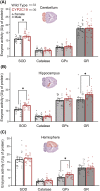The humanised CYP2C19 transgenic mouse exhibits cerebellar atrophy and movement impairment reminiscent of ataxia
- PMID: 36536486
- PMCID: PMC10108232
- DOI: 10.1111/nan.12867
The humanised CYP2C19 transgenic mouse exhibits cerebellar atrophy and movement impairment reminiscent of ataxia
Abstract
Aims: CYP2C19 transgenic mouse expresses the human CYP2C19 gene in the liver and developing brain, and it exhibits altered neurodevelopment associated with impairments in emotionality and locomotion. Because the validation of new animal models is essential for the understanding of the aetiology and pathophysiology of movement disorders, the objective was to characterise motoric phenotype in CYP2C19 transgenic mice and to investigate its validity as a new animal model of ataxia.
Methods: The rotarod, paw-print and beam-walking tests were utilised to characterise the motoric phenotype. The volumes of 20 brain regions in CYP2C19 transgenic and wild-type mice were quantified by 9.4T gadolinium-enhanced post-mortem structural neuroimaging. Antioxidative enzymatic activity was quantified biochemically. Dopaminergic alterations were characterised by chromatographic quantification of concentrations of dopamine and its metabolites and by subsequent immunohistochemical analyses. The beam-walking test was repeated after the treatment with dopamine receptor antagonists ecopipam and raclopride.
Results: CYP2C19 transgenic mice exhibit abnormal, unilateral ataxia-like gait, clasping reflex and 5.6-fold more paw-slips in the beam-walking test; the motoric phenotype was more pronounced in youth. Transgenic mice exhibited a profound reduction of 12% in cerebellar volume and a moderate reduction of 4% in hippocampal volume; both regions exhibited an increased antioxidative enzyme activity. CYP2C19 mice were hyperdopaminergic; however, the motoric impairment was not ameliorated by dopamine receptor antagonists, and there was no alteration in the number of midbrain dopaminergic neurons in CYP2C19 mice.
Conclusions: Humanised CYP2C19 transgenic mice exhibit altered gait and functional motoric impairments; this phenotype is likely caused by an aberrant cerebellar development.
Keywords: animal models; cerebellar ataxia; cerebellum; cytochrome P-450 Cyp2c19; movement disorders; neuroimaging; transgenic mice.
© 2022 The Authors. Neuropathology and Applied Neurobiology published by John Wiley & Sons Ltd on behalf of British Neuropathological Society.
Conflict of interest statement
All authors declare no conflict of interest.
Figures





References
-
- Gandini J, Manto M, Bremova‐Ertl T, Feil K, Strupp M. The neurological update: therapies for cerebellar ataxias in 2020. J Neurol. 2020;267(4):1211‐1220. - PubMed
-
- Zesiewicz TA, Wilmot G, Kuo SH, et al. Comprehensive systematic review summary: treatment of cerebellar motor dysfunction and ataxia: report of the guideline development, dissemination, and implementation Subcommittee of the American Academy of neurology. Neurology. 2018;90(10):464‐471. - PMC - PubMed
-
- Jukic MM, Opel N, Strom J, et al. Elevated CYP2C19 expression is associated with depressive symptoms and hippocampal homeostasis impairment. Mol Psychiatry. 2017;22(8):1155‐1163. - PubMed
Publication types
MeSH terms
Substances
LinkOut - more resources
Full Text Sources
Medical

